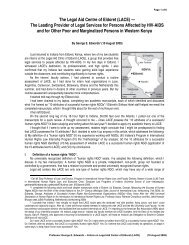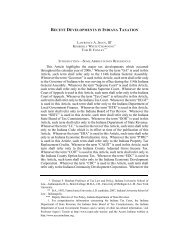Alumni Magazine & Dean's Report - I.U. School of Law - Indiana ...
Alumni Magazine & Dean's Report - I.U. School of Law - Indiana ...
Alumni Magazine & Dean's Report - I.U. School of Law - Indiana ...
You also want an ePaper? Increase the reach of your titles
YUMPU automatically turns print PDFs into web optimized ePapers that Google loves.
His lecture focused on the history and evolution <strong>of</strong> the U. S.<br />
Supreme Court and he noted the many ways in which the Court<br />
<strong>of</strong> 1910 differed from today’s Court. Not only was the Court then<br />
housed in a part <strong>of</strong> the U.S. Capitol Building, instead <strong>of</strong> its own<br />
impressive structure, it was also a “court <strong>of</strong> error” and did not control<br />
its docket the way it does today. Thanks to the Court’s ability to adapt<br />
and evolve, today it focuses its resources on a “limited number <strong>of</strong><br />
nationally important issues that have traditionally divided the lower<br />
courts <strong>of</strong> appeal,” making it a stronger and more effective Court.<br />
He also spoke on the importance <strong>of</strong> judicial independence<br />
and the need for maintaining the separation <strong>of</strong> the three branches<br />
<strong>of</strong> government. The independent nature <strong>of</strong> the Supreme Court<br />
becomes immediately apparent after one is appointed to it for life,<br />
he noted. He said his relationship with the current President was<br />
really no different than it had been with his predecessor. On social<br />
occasions, for example, when seated next to the President, with Mr.<br />
Bush he would <strong>of</strong>ten talk about sports, while he and Mr. Obama<br />
have discussed their experiences as fathers <strong>of</strong> young children.<br />
When asked about the increasingly strident language <strong>of</strong> the<br />
court, he noted it did not connote increased divisiveness or great<br />
personal division among the justices. He pointed out that there<br />
were not many jobs where everyone does the exact same thing, as<br />
all nine justices do—reading, hearing and deciding the exact same<br />
cases together. The nature <strong>of</strong> the work is a bonding experience.<br />
Following the lecture, Chief Justice Roberts visited the<br />
overflow room in which approximately 50 students and alumni<br />
watched the proceedings via closed circuit broadcast, and took<br />
questions from them before joining the reception in his honor<br />
held in the Conour Atrium.<br />
Dean Gary R. Roberts thanked the Chief Justice for his<br />
extreme generosity with his time while visiting the law school.<br />
Earlier in the day, the Chief Justice made unannounced visits<br />
to two first-year classes, taking questions from the astonished<br />
and delighted students. He also dined at a private luncheon<br />
with law school faculty.<br />
Chief Justice Roberts is the third member <strong>of</strong> the Supreme<br />
Court <strong>of</strong> the United States to speak in this lecture series. Justice<br />
Sandra Day O’Connor gave the inaugural James P. White Lecture in<br />
2002, and Justice Ruth Bader Ginsburg spoke in 2007. Additionally,<br />
John G. Roberts, Jr. was preceded by two other Chief Justices<br />
as the James P. White Lecturer. Lord Woolf, Lord Chief Justice<br />
<strong>of</strong> England and Wales spoke in 2005 and John L. Murray, Chief<br />
Justice <strong>of</strong> the Supreme Court <strong>of</strong> Ireland, spoke in 2009.<br />
The James P. White Lecture on Legal Education was<br />
established in 2000 to honor Pr<strong>of</strong>essor Emeritus James P. White,<br />
who served for 25 years as the American Bar Association’s<br />
Consultant on Legal Education. White’s colleagues at the ABA<br />
and other friends contributed to the establishment <strong>of</strong> the annual<br />
lecture series in his honor.<br />
I U S C H O O L O F L AW S U M M E R A L U M N I M A G A Z I N E<br />
Thanks to the<br />
Court’s ability to<br />
adapt and evolve,<br />
today it focuses<br />
its resources on a<br />
“limited number <strong>of</strong><br />
nationally important<br />
issues that have<br />
traditionally divided<br />
the lower courts <strong>of</strong><br />
appeal,” making it a<br />
stronger and more<br />
effective Court.<br />
The Chief Justice posed with Pr<strong>of</strong>essor James<br />
P. White for whom the lectureship is named.




